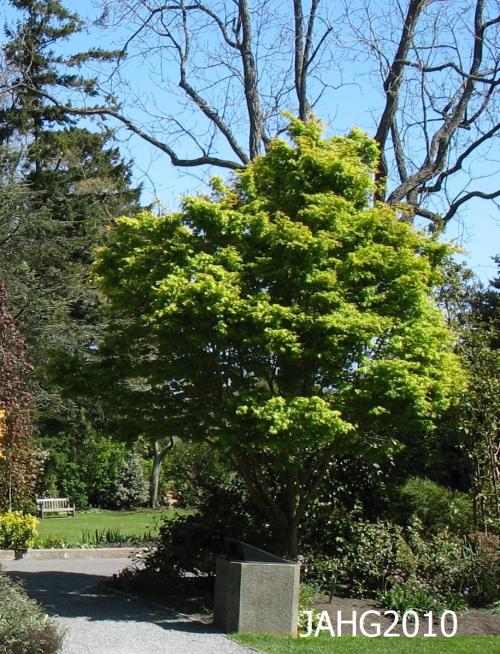The cold has set in. Change is beginning to be noticed in some plants which take on different hues and tones during the colder months. Most noticeable is the change in some conifers which take on bronzy tints. Other plants also get tinged leaves often with richer coloring. Some bark of trees even becomes more distinct in coloring. One tree which is a standout (literally) is the Coral Bark Maple (Acer palmatum ‘Sango Kaku‘). The already coral-red coloring of the bark deepens in tone and stands out from all other trees.
Most people know the Japanese Maple (Acer palmatum) which is almost over used in many places. It was first described by Carl Peter Thunberg, he brought drawing of the tree back from Japan where he was stationed during the period of 1775-76. It was Thunberg who named the small tree using ‘palmatum’ to describe the small leaves as ‘hand-like’.
The ‘hand-like description is very similar to the Japanese name for Maple leaves ‘kaede’. Kaede refers to the leaves resembling small (baby) hands or (kaeru)frog +(de) hands. Momiji(momizu) is also used as meaning Maples but more correctlyrefers to the leaves turning red in autumn as Maples usually do. The first live Acer palmatum arrived in England in 1820 and since that time the trees have remained popular.
Japanese Maples where a highly developed plant by the time they were brought to Europe. In Japan the first place these trees were known to be written about was in ‘Kadan Chikinsho’ (by San Nojo Hanado), a 6 volume work on the ornamental trees and shrubs of Japan published in 1685. Later there was revisions to the book and a complete volume was given over to Acer palmatum and its known forms. Breeding and specialization of plants really took of during the ‘Edo period (1603-1867) in Japan, at that time there were even cults devoted to certain plants. In 1770 there were 36 named varieties and by 1882 the list had grown to include about 250 varieties. It is not known how old Acer palmatum ‘Sango Kaki’ is. Some of old varieties have been lost during the 2nd World War as the trees were cut down and used as fuel. Since the 1960s there has been a resurgence of interest in the trees and hundreds of new varieties have been collected from Japan and around the world where these trees are collected and propagated.
There is some confusion with the naming of the Coral Bark Maple: its correct name is Acer palmatum ‘Sango Kaku‘. In the past it been listed as ‘Senkaki’ which is wrong, there is no known plant by that name. Now there is a problem in getting a true ‘Sango Kaki’ as some trees which are sold with this name are likely to be selected seedlings of the same parent. All named Japanese Maples are propagated by cuttings which are then grafted onto a more vigorous understock. This is a slow and expensive process, therefore you need to select your plant from a reputable grower and be suspicious of unusually cheap plant offerings. the best time to buy a plant is in the fall when you can inspect the bark coloring and select the deepest coloring.
Acer palmatum ‘Sango Kaki’ like all Japanese Maple is a fairly easy plant to grow. It likes fertile, slightly acid well-drained soil. They like to be kept evenly watered at all times, changes in watering can damage the plant. They like full sun here in the north-west but need shade in areas with more intense light. All Japanese Maples should be protected from drying winds regardless if they be in the summer or winter, their leaves and bark are thin and damaged easily. Best siting for this plant will take advantage of the tree coloring throughout the year, colors in the background should be chosen to make the tree stand out more. These trees like As mentioned selection of the plant takes some care, at that time make sure the roots are in good condition. The roots are fine and these trees are best bought in a container.

As the branches get older the coral coloring of Acer palmatum 'Sango Kaku' blends in with older bark.
All Acer palmatum make excellent container subjects, I have several which are growing in large pots for many years. The Coral Bark Maple should be used as a specimen as it has wonderful coloring throughout the year. These trees also look wonderful in dark borders or with other plants which will highlight the red bark of this plant. This plant grows to about 4.5-6 m. (15-20 ft). It has a narrower vase shape and has a spread of maybe 1/3 less than height or 2.5-5 m.(10-15 ft.). It has a hardiness rating of zones 6 though 9 or -20 c.(-10 f.).

Autumn brings the return of the buttery yellow and amber often edged with crimson to the Coral Bark Maple.
Crimson tidings lead us to:
Rainyside speaks to us: http://www.rainyside.com/features/plant_gallery/shrubs/AcerSango-kaku.html
Wiki on Acer palmatum: http://en.wikipedia.org/wiki/Acer_palmatum
‘Sango-Kaku’ vs other similar and incorrectly named trees: http://www.ubcbotanicalgarden.org/forums/showthread.php?t=394
……Hope to see you soon again here….












 Stumble It!
Stumble It!






